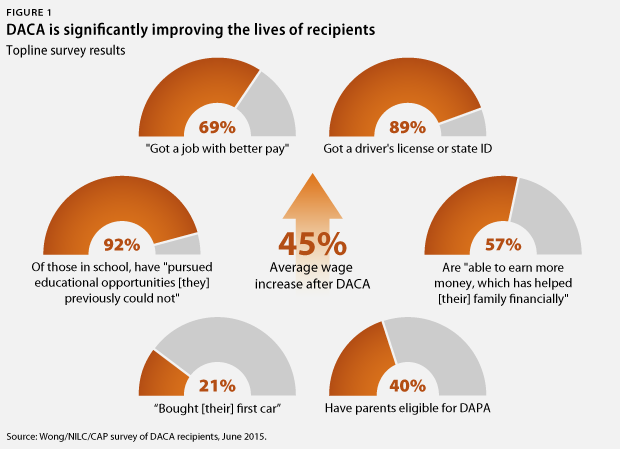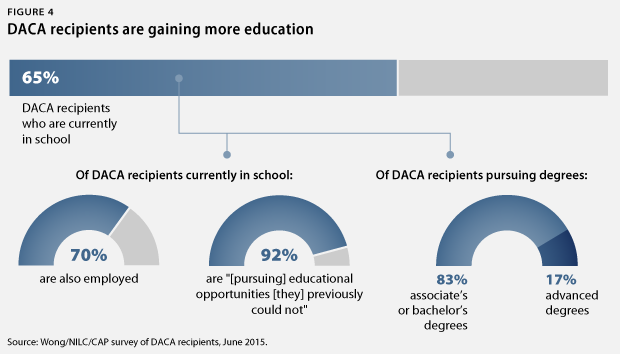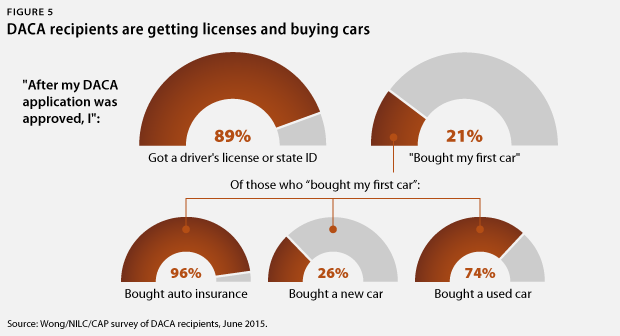Note: The 2019 version of this survey can be found here.
In June, the Deferred Action for Childhood Arrivals, or DACA, program—which allows eligible unauthorized immigrants who entered the country at a young age to apply for temporary deferrals of deportations and work permits—marked its third anniversary. To date, roughly 665,000 people have received DACA. A number of early surveys illustrate that DACA has improved the lives of its recipients, and economic impact analyses have found that wages rise as recipients gain work authorization, get jobs that better match their skills and training, and invest more in higher education.
Following up on these studies, the National Immigration Law Center, or NILC, the Center for American Progress, and Tom K. Wong of the University of California, San Diego, conducted a national survey to analyze the economic and educational outcomes of DACA recipients. The survey is part of a broader ongoing study by Wong called the Administrative Relief Impact and Implementation Study. The results add to a growing body of research that illustrates how DACA significantly affects recipients. (see Figure 1) A full 96 percent of respondents are currently employed or in school. Many are getting better, higher-paying jobs than they had before they received DACA. They are buying cars at high rates, and many are pursuing educational opportunities previously unavailable to them.

The survey is also one of the first to systematically quantify the wage effect of having deferred action. The data show that DACA has increased recipients’ average hourly wages 45 percent. Given that higher wages translate into more tax revenue and more economic growth, these findings suggest that DACA benefits all Americans.
Methodology
The survey was fielded online during June 2015 with a sample size of 546 respondents. Of these respondents, we can be confident that 467 are DACA recipients. Following the standards set forth by Wong and Valdiva in 2014, the survey included multiple features to enhance confidence in the validity of its findings. First, it included a unique validation test for undocumented status, which excluded some individuals from the sample based on their responses to questions about their immigration history. Moreover, no financial incentives for participation were provided; this was to further protect against responses from documented individuals. The survey addressed the issue of ballot stuffing, or one person taking the survey multiple times, by using a state-of-the-art online survey platform that prevents any single internet protocol, or IP, address from submitting multiple responses. The data were also checked for duplicate responses. While the survey utilized a peer-to-peer sampling strategy to identify DACA recipients, Facebook advertisements were also used in recruitment. This helped create a wider respondent base.
The survey respondents live in 34 states and the District of Columbia and have a median age of 22. Overall, 73 percent are female and 26 percent are male. The higher proportion of females is a recurring trend in online surveys of undocumented young people.
The vast majority of respondents—84 percent—identify as Hispanic/Latino, while another 9 percent identify as Asian, 2 percent identify as black, 2 percent identify as white, and 2 percent identify as other. Compared with the latest estimates of the DACA-eligible population, Hispanic/Latino respondents are slightly overrepresented in this sample. Nonetheless, given the demographic breakdown of approved applications—with 78 percent of DACA recipients born in Mexico and at least another 9 percent born in Central America*—the data likely track with the racial and ethnic distribution of the program.
DACA’s impact on employment
The survey finds that DACA has significantly helped recipients participate in the labor force. Seventy-six percent of respondents are currently employed, with an additional 20 percent not working but in school. As Figure 2 shows, after receiving DACA, 69 percent of respondents report moving to a job with better pay; 57 percent report moving to a job that “better fits my education and training;” and 54 percent report moving to a job with better working conditions.

DACA’s impact on earnings
Nearly two-thirds of respondents—62 percent—“have been able to earn more money, which has helped me become financially independent.” Additionally, 57 percent say that earning more money “has helped my family financially.”
As Figure 3 indicates, DACA has increased average wages 45 percent, moving from $11.92 per hour before receiving DACA to $17.29 per hour after receiving it. This means an average of $5.27 more per hour and a median increase of $4. Because the baseline hourly wage is modest, and many of these individuals are new to the labor force, even relatively small wage bumps result in large percentage increases.
The findings make clear that DACA has created a way for undocumented youth to find better-paying jobs. Future research will help better assess the short- and long-term nature of DACA wage effects as recipients gain more work experience and progress in their careers. Importantly, future research should identify whether short-run wage effects represent a plateau in earnings or whether an even more robust longer-run wage effect exists.

DACA’s impact on education
Overall, 65 percent of respondents are currently in school. Of these, 70 percent are currently working as well. As Figure 4 illustrates, the majority are pursuing undergraduate degrees, and 17 percent are pursuing advanced degrees. Ninety-two percent of the respondents who are currently in school say that, because of DACA, “I pursued educational opportunities that I previously could not.”

DACA recipients on the road
The survey finds that 89 percent of respondents have obtained a driver’s license or state ID for the first time after receiving DACA. Moreover, 21 percent of respondents report buying their first car after receiving DACA, with 26 percent buying a new car and 74 percent buying a used car. A full 96 percent of the people who bought a car have purchased auto insurance.
The average cost of car purchases in the sample was $22,559 for new cars and $9,607 for used cars. This matters for state revenue, as most states collect between 3 percent and 6 percent of the purchase price in sales tax, as well as registration and title fees. This added revenue comes in addition to the inherent safety benefits—to all Americans—of having more licensed and insured drivers on the roads.

These results help inform one of the central premises in the legal challenge brought by Texas and other states to the legality of the deferred action programs—the DACA expansion and Deferred Action for Parents of Americans and Lawful Permanent Residents, or DAPA—that President Barack Obama announced in November 2014. Texas claimed harm from DAPA because Texas charges less in driver’s license fees than it costs the state to issue them.
However, Texas did not take into account any of the new tax revenue that would accrue from people gaining deferred action: The survey data show that 33 percent of Texas respondents bought a car after receiving DACA at an average cost of $10,346. At a tax rate of 6.25 percent, this translates to an average state tax payment of $647 per car, not counting registration and title fees. Although one should take caution when extrapolating from a sample to a population, the findings are clear: Texas stands to gain significant amounts of new tax revenue from individuals who gain deferred action, get driver’s licenses, and buy cars.
Families of DACA recipients
The survey underscores the deep ties that DACA recipients have to U.S. citizens and illustrates the diverse legal statuses that members of the same family can have. Forty-five percent of respondents have siblings who are citizens, while 40 percent have a parent who is eligible to apply for deferred action under DAPA.
Conclusion
From new jobs and better earnings to more education and car purchases, DACA is having a major impact on individual lives. But it is only one piece of the puzzle: While up to 1.17 million individuals are currently eligible to apply for DACA, an additional 4 million or so people would be eligible to apply for the 2014 deferred action programs, which remain on hold in the wake of the Texas lawsuit.
Given DACA’s broad economic and societal benefits, allowing deferred action to move forward would reap even larger rewards. Deferred action provides only temporary protections, however, and a more permanent solution in the form of comprehensive immigration reform legislation—anchored by a pathway to citizenship for undocumented immigrants—would yield even greater benefits and provide increased prosperity for all Americans.
* Authors’ note: 8.7 percent of applicants were born in Costa Rica, El Salvador, Guatemala, and Honduras. Figures for Nicaragua, Panama, and Belize are not available.
Tom K. Wong is an assistant professor of political science at the University of California, San Diego. Kelly K. Richter is the executive action policy fellow and Ignacia Rodriguez is the equal justice works fellow, sponsored by Greenberg Traurig, at the National Immigration Law Center. Philip E. Wolgin is the Associate Director for Immigration Policy at the Center for American Progress.